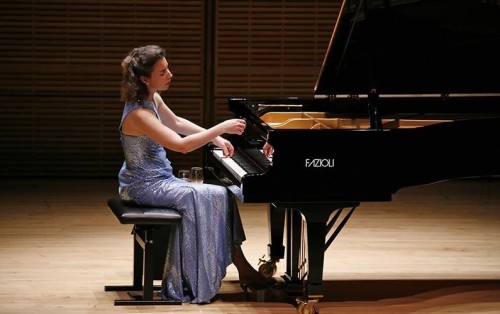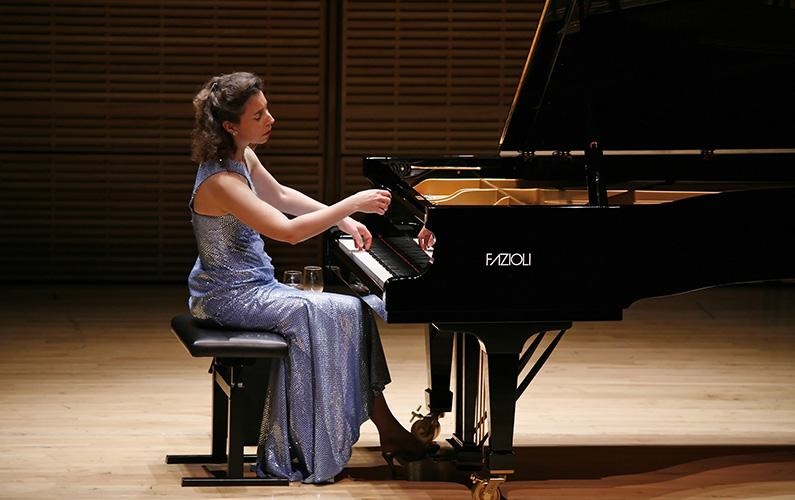 United Kingdom Angela Hewitt Masterclass: Wigmore Hall, London, 22.4.2016. (CC)
United Kingdom Angela Hewitt Masterclass: Wigmore Hall, London, 22.4.2016. (CC)

Christian Sandrin (Royal Academy of Music)
Schumann Kreisleriana, Op. 16
Jonathan Ferrucci (Guildhall School of Music and Drama)
Bach Partita No. 2 in C minor, BWV826
Drew Steanson (Trinity Laban Conservatoire of Music & Dance)
Bach Toccata in E minor, BWV914
Brahms Intermezzo, Op. 117 No. 1
Samson Tsoy (Royal College of Music)
Beethoven Fantasia in G minor/B major, Op. 77
This was a fascinating Friday afternoon. Scheduled for 1400-1700, it was timed to perfection by Hewitt, but not without the odd casualty: Debussy’s Images Book II (Jonathan Ferrucci) was left “for another time”, whole the scheduled complete Brahms Op. 117 was trimmed to just the first. No matter: there were still joys a-plenty here. Hewitt’s methodology was to hear the entire piece, seated at the front of the stage, side-on to the audience, annotating the student’s score all the while so they get a written record of what’s gone on (and, I’m sure, receive a lot more advice than we were privy to in the 40-minute segments), and then run through selected passages at the end. She interspersed this with the occasional anecdote, thus including the audience in the process. She is someone who sees the best in the pupil’s playing, always encouraging, and her persona is beautifully warm. Inevitably, the piano used was a Fazioli, a make that inspires much praise from Hewitt in its responsiveness. She has played Faziolis for 15 years and finds it a most “creative” make of piano, with incredible power; and it doesn’t lose its “ring” at the lower dynamic levels.
First up was Bucharest-born Christian Sandrin, in his final year at the RAM, a pupil of Diana Ketler. We heard Schumann’s Kreisleriana all the way through (which surprised me, given it is no slip of a piece), which gave the audience time to weigh up his playing. My notes include over-projecting in terms of sound – the Wigmore chestnut – and blurring; Hewitt saw the positives (“great tone, great phrasing”) before positing that there are more characters in Schumann than Florestan and Eusebius. Hewitt rightly pointed out that instead of over-projecting the sound, it is the characterisation that needs over-emphasis, from the player’s point of view, and quoted C. P. E. Bach to that effect. Technical matters were addressed, too (posture, in terms of shoulders and hunching), while Hewitt’s Bachian bent surfaced in the concentration on linear workings. Clean counterpoint was a recurring theme; she also practices Schumann without pedal, then adds it in later – how many amateur pianists, I wonder, would dare do that? A guaranteed X-Ray into both technique, and pedal-reliance.
Jonathan Ferrucci, from the GSMD and a pupil of Joan Havill, seemed more settled as a player, presenting the complete Bach Second Partita. Yet it needed enlivening (the Sarabande tended towards tedium). Hewitt was very positive but made points that just underline her strengths in this, the most beloved section of her repertoire: when bringing out a voice, don’t lose the other parts, and always keep in mind directionality. And an over-reliance on pedal was most definitely advised against, as was releasing chords with the pedal (a particular bugbear of mine – it always sounds messy, whatever the repertoire). It was interesting to watch her conduct him as he played; a measure of her involvement, perhaps. What was really fascinating was that when Hewitt guided her pupil to think in the longer terms, she took a segment of the score and played a harmonic reduction – effectively creating a Middleground Schenker graph on the spot. There was another interesting jewel: “I will preach to the day I die that Courantes are not that fast”, citing Louis XIV (this was his favourite dance, and involved lots of footwork); while in the Sarabande, “everything has to sing”. So much time spent on Bach meant there was none of the scheduled Debussy, as noted above.
After the interval, British-Australian pianist Drew Steanson, a pupil of Martino Tirimo at Trinity, gave us Bach’s E minor Toccata, BWV914. Another pianist with a big sound who over-projects for the Wigmore acoustic, but who has terrific finger-strength – Hewitt thought he was a organist. Hewitt let slip that she will be playing all the Bach Toccatas at the Wigmore in 2019, incidentally. Her entreaty that he “play it with intent so that people know you haven’t made a mistake” was sound advice indeed, but she liked his performance, and rightly. Advice was to the point – “touch has to sparkle even when pianissimo”; and the importance of gestural playing to generate tension. This time there was space for at least some of the scheduled second piece: instead of all three Intermezzos of Brahms’ Op. 117, we had just the first. Its rocking chords (“not too slowly”, she said before he even played) hold much beauty but Hewitt counselled implicitly against too much indulgence, not just in terms of tempo. Last year, she said, she learned Brahms’ D minor Concerto and was amazed that there was “so much Bach” there. When Hewitt demonstrated a section, we moved from the good of Steanson to the magical. Thanks also to Hewitt for introducing me, at least, to the fabulous poem Romantics (Johannes Brahms and Clara Schumann) by Liesl Mueller. As Hewitt put it, “the more you give yourself to this music, the more it gives back to you”.
Finally, we heard Kazakh-born Samson Tsoy, a graduate of the Royal College of Music. His interesting choice was the Beethoven Fantasia in G minor/B major, Op. 77. He had an excellent feel for Beethoven, and this is a tricky piece. His performance was fluent, and he had a lovely ringing bass. Hewitt described the piece as “Beethoven running amok” and posited that “I think it needs a lot of help”. Her advice was to make more of the gestural (the work is certainly that) and to be “wilder”, and “crazier”. There was a rare entreaty to imagine an instrumental sound at one point (Brendel famously advocated this in Musical Thoughts and Afterthoughts): she asked to make the tenor line “sound more like a horn”. Possibly Tsoy had the greatest triumph of the day, for by the end Hewitt had admitted that she’s “beginning to like the piece”. If you need a pointer towards a performance that presents Op. 77 at its best, try Serkin (the 1947 mono account).
At the close, during a brief Q&A, Hewitt explained how the day came about. She had received a list of the pieces the students were presenting (they were not her choices), which elicited the gem “as long as they don’t play Rachmaninov, I don’t care what they play”. She also noted that there were no females in the list and that a leitmotif of the afternoon was the maintaining of intensity throughout a piece. And recording plans for Hewitt? More Beethoven (one a year: Volume 6 of her sonata cycle for Hyperion includes Op. 31/1, “Les Adieux”, plus the Op. 49 and Op. 14 sonatas) and a re-recording of the Bach Goldberg Variations, then a second disc of Scarlatti before Beethoven Volume 7 comes across the horizon.
This was my first experience of masterclasses at the Wigmore, and it was a thoroughly enjoyable, not to mention educational, one. In early November this year, the Wigmore will present two masterclasses with Brigitte Fassbaender (November 3 & 4).
Colin Clarke
